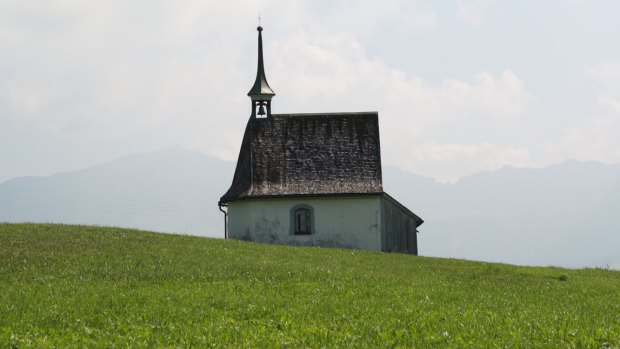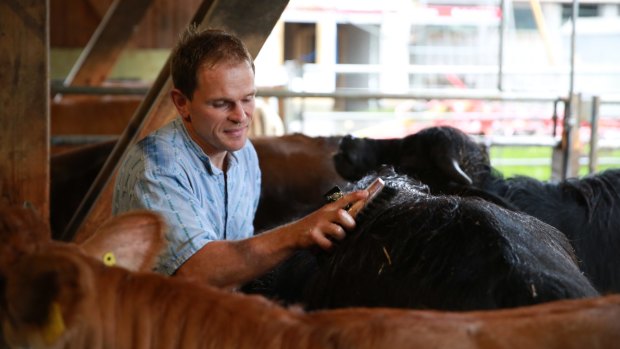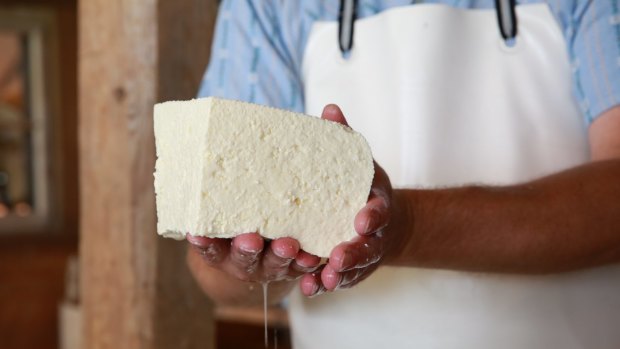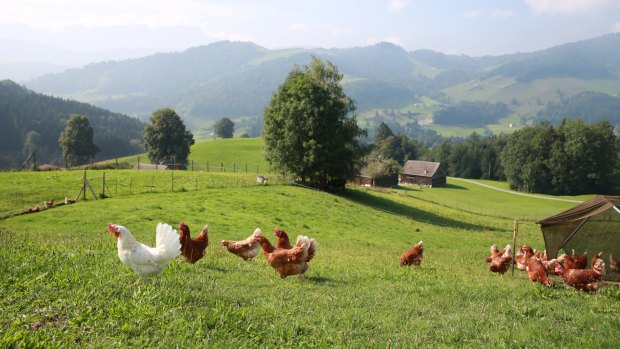This was published 7 years ago
Appenzell, Switzerland: The Swiss town of beer-drinking cows
By Catherine Marshall

Farmhouse.Credit: Catherine Marshall
The cows are drinking beer, the beer is being brewed from the spring water that surges through the Alpstein massif, the herb-brined cheeses are ripening in the cellars and the chickens are running wild and free on the side of a lurid green mountain in the Swiss canton of Appenzell.
It's a scene straight from a Disney film – sparkling landscape, contented animals, fresh food, rosy-cheeked residents – but it's not too good to be true. In fact, for the cows living on Sepp Dahler's farm, Blindenau (meaning, curiously, "pastures of the blind"), in the village of Stein near the German border, it doesn't get much better than this: they're blissed out beneath a shelter as the rain falls softly around them and Dahler massages their bulky frames with beer. He dips his brush into a bucket of the hoppy liquid and swipes it back and forth across their flanks. Their eyes glaze over. Their noses tip up towards the sky. They look as though they're moving to plant a kiss on their master's lips.
But perhaps it's not gratitude they're displaying, after all; perhaps that chilled-out demeanour has more to do with the beer they've been drinking than the affection they're receiving. These Kobe beef cattle (known here as Kabier) are fed the yeast-rich by-products of the beer-making process. A motley bunch – there are Swiss Browns, charolais, limousin, even a couple of water buffalo – they're farmed in small herds and allowed to range free, unlike their Japanese counterparts, but in keeping with those chickens and pigs and other animals that keep the people of Apenzell fed. Consequently, says Dahler, these supple, beer-loving animals are healthier and more flavoursome than most.

Sepp Dahler.Credit: Catherine Marshall
The undulant hills surrounding the village of Stein are painted a shade of green so improbable it seems to have been sprayed on. Dahler's farm once supported dairy cattle, but changes to Swiss farming regulations (those animal protection laws and organic food production that are now commonplace in that country) prompted him to rethink his strategy. He started growing wheat for a local brewery and it was then that he hit on an idea: to use the brewing remnants to farm Japanese-style Kobe beef.
With the cows suitably pampered (they'll receive a second massage later today, this time with rapeseed oil to ensure a glossy coat), the farmer-come-masseuse leads me up the barn stairs to a table set with Kabier sausage and pork sausage (made from Dahler's free-range – and, yes, beer-swilling – pigs). A selection of utilitarian products is laid out too: clogs and belts and handbags crafted from those smooth and glossy hides. The meat, too, is faultless: rich, fresh and flavoursome. And though it might just be the hops scenting this place, I'm sure it tastes of beer, too.
It's humans, rather than cows, drinking beer 10 minutes' drive away at Appenzeller Bier, a family brewery that makes its drinks with spring water collected right at its source in the nearby Alpstein massif. It's another clever reimagining of local resources: though German and English tourists would come to Appenzell by horse and coach in the 1800s to wallow in the springs – discovered many centuries ago by a monk – and drink a health-giving beverage of mineral water and whey, tourism gradually dropped off. The Locher family had to dream up new ways of making a living, and so in 1886 they took over Appenzell's brewery. It has remained in the family ever since.

Cheese straight from the farm.Credit: Catherine Marshall
The ingredients for these soft, fruity beers are set out at the brewery's visitor centre in the village of Appenzell: barley and coriander and wheat, yeast and hop pellets and soft tufts of hemp. The latter was first used in beer by monks, visitor centre manager Claudia Nyffeler tells me.
"But it was found to work as an aphrodisiac, and so the church told them to stop," she says. Then, smiling craftily, "We call this one a sleeping tablet in a bottle."
In the adjoining tasting room, Nyffeler has set out the range of beers, each label a pastoral Appenzell scene painted by local artists. Hemp is not the only clever idea contained within the brew collection: there is a wheat beer made with organic banana, another spiked with orange peel and coriander, a dessert beer made from chestnuts, and the full moon beer, in which the brewer has conjured the power of this astrological phase. But most intriguing is the Brand Loscher – or "fire extinguisher" – beer, which commemorates a fire in 1560 in which the whole village of Appenzell burned down. The town guard, it is said, was drinking beer when he should have been watching for sparks.

Picture perfect farmland.Credit: Catherine Marshall
"Our firefighters like this beer," says Nyffeler. "We also say that in the beer is exactly what the firefighters need: water, CO₂ and foam."
This careful guarding of traditions in Appenzell is replicated across the district in summer, when farmers turn their Swiss Browns' sweet, fresh milk into Appenzell cheese. So famous and beloved is this product, it has been trademarked; in some miraculous effort at collective secrecy, local cheesemakers have kept the recipe from the outside world, revealing only this: that it's made from raw milk flavoured by the herbal meadows upon which their liquid-eyed cows graze all summer; and that its spicy tang is delivered by a mysterious herbal brine applied to the cheese during the maturation process.
When this recipe was first recorded in Appenzell around 700 years ago, it was a tough place in which to live. The region fell under the rule of a monastery, and the people were taxed in cheese and whey. They would take their dairy cows up into the Alps in spring, and all summer the animals would graze on grass made sweet by the high altitude. The cheese would be made up there in the secret folds of the mountains, the whey softening the hands of the cheesemakers so that they never aged.
"Taxpayers wanted to give good quality [cheese] to the monks," says Maria Ebneter, a guide at the Appenzeller Show Dairy.
"So they used flowers from the alps to make a brine: sage, rosemary, cloves, star anise, laurel, mugwort, tarragon, juniper."
This is an incomplete list of ingredients, of course, but gives those wanting to replicate the sharp, zingy cheese a clue at how to get started. I have no such intentions myself, but am happy to try my hand at making a dish of traditional Appenzeller chaashornli in the dairy's restaurant, Hockli. I cook the chaashornli – curls of pasta whose name means "cheese horns" – in a rich bouillon, add it to a blend of fresh Swiss Brown cream, spices, white wine and that sublime Appenzell cheese, and pair it with fried onions and apple puree.
The dish is simple but delicious. Scooping forkfuls into my mouth, I decide that I don't mind that the people of Appenzell have kept their cheese recipe a secret; I'm just so happy to be able to eat it.
TRIP NOTES
MORE INFORMATION
GETTING THERE
SWISS International Air Lines offers daily connections from all major Australian ports via Hong Kong, Bangkok and Singapore along with airline partners. Return economy fares from $1820 including taxes. Australian passport holders don't need a visa for Switzerland. See www.swiss.com
GETTING AROUND
The Swiss Travel Pass gives travellers unlimited access to Switzerland's transport network of trains, trams, buses and boats as well as free entrance to over 480 museums and exhibitions and a 50 per cent discount on mountaintop trains and cable cars. Prices start at $304 for a three-day consecutive adult pass, based on two people travelling together. See myswitzerland.com/rail. Kabier beef, cheese and beer-tasting tours can be booked through Appenzellerland Tourism. www.appenzell.ch/en/home
Catherine Marshall was a guest of Switzerland Tourism.
Sign up for the Traveller Deals newsletter
Get exclusive travel deals delivered straight to your inbox. Sign up now.